Illinois
| |
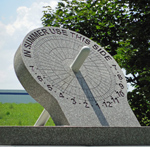 |
Hawthorn Woods |
Illinois |
USA |
Equatorial Dial |
Dial 876 |
| This equatorial dial sits on a 61-inch octagonal base that serves as a columbarium. The dial is reminiscent of Erickson Memorial sundials. This granite sundial is 38.5 inches in diameter and 6 inches thick. The 3-inch diameter gnomon is made of hollow galvanized steel pipe with a white powder coating. The engraving on the sundial was done using a rubber stencil and sandblasting with aluminum oxide abrasive. No water jet was used. The center core hole was cut using a diamond segmented coring machine, like a big drill press with an expensive hole saw. |
| |
| |
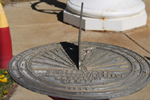 |
Hawthorne |
Nevada |
USA |
Horizontal Dial |
Dial 1080 |
| Farenholt sundial for U.S. Naval Ammunition Depot Hawthorne Nevada. This cast bronze dial was designed and commissioned by RADM Farenholt for U.S. Naval Hospitals at bases where he was commanding officer, visited, or had special meaning to him. The dial is 18 inches (46cm) in diameter. The outer chapter ring has the motto, followed by a chapter ring with Arabic hours 6am to 6pm, raised hour lines that radiate from near the foot of the gnomon and short half-hour lines. The gnomon has graceful curves and a star cut-out in the center. Below the gnomon is the naval command name, followed by the commissioning date in the southern portion of the hours chapter ring. |
| |
| |
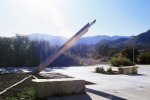 |
Heber City |
Utah |
USA |
Horizontal Dial |
Dial 531 |
| A 51 x 36 foot horizontal dial with a 21 foot welded silicon bronze gnomon standing 14 feet high. The hour lines are copper inlaid in concrete and the hour markers are 4 inch high bronze Arabic numerals. At solar noon, sunlight passing through a slit in the gnomon illuminates the noon marker with a line of sunlight while prisms on the end of the gnomon project rainbows onto this line of light, making the sculpture a seasonal calendar as well as a way to tell time.
Created by sculptor Robert Perless, Sun Dagger functions as a unique celestial observatory to amplify the synergy of man and nature. It also works as a seasonal calendar, celebrating the winter and summer solstices and the vernal and autumnal equinoxes with rainbows crossing the line of sunlight from the gnomon slit and falling on inscribed plaques. |
| |
| |
 |
Heber City |
Utah |
USA |
Cylindrical Dial |
Dial 47 |
| A 10 inch wide, cylindrical-segment equatorial dial 8 inches high, fabricated from a section of large PVC pipe. The dial face is aluminum sheet bonded to the PVC pipe and marked by photochemical engraving with hour lines showing analemmas to correct for EOT; hour lines are corrected for longitude and show both standard and daylight saving Arabic hour numerals. Winter and summer solstices and equinoxes are marked. The gnomon is a pointed brass rod. Instructions for use are included on dial face. |
| |
| |
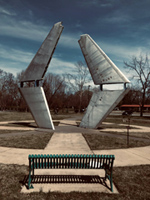 |
Hermitage |
Tennessee |
USA |
Horizontal Dial |
Dial 1055 |
| The gnomon consists of two complete horizontal stabilizer wings from a Boeing 727 jet, arranged in a sculpture called "Clear for Landing". The dial is 72 feet (22m) in diameter. The hour markers are Roman numerals in granite stone blocks. The hour lines were laid out using a scale model mounted on a heliodon and set for the summer solstice. The leading shadow of the vertical sculture marks the time. The planes landing at Nashville airport serve as the backdrop to the dial. When the sun is due East-West, the wings form a diamond, allowing shadows to fall through the markers onto the inlaid concrete disk. |
| |
| |
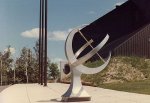 |
Hibbing |
Minnesota |
USA |
Equatorial Dial |
Dial 375 |
| An 8 ft high equatorial sundial designed and built by David Aho. Made of welded stainless steel with a brass gnomon and brass equatorial arc dial. The 60 inch diameter equatorial dial is engraved. |
| |
| |
 |
Highland Park |
Illinois |
USA |
Polar Dial |
Dial 377 |
| This cast iron polar dial is centered in a 7 foot diameter, echoing the form of a "train wheel", matching the theme of a small park situated between a historic train station on the ancient Green Bay Trail and a pioneer cemetery. The polar dial has raised hour lines on the cast iron plate. Designed by Stephen Luecking and built at St. Mary's Foundry. |
| |
| |
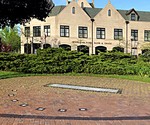 |
Highland Park |
Illinois |
USA |
Analemmatic Dial |
Dial 400 |
| A nicely done analemmatic dial approximately 15 feet across with a grey granite zodiac walkway. The granite walkway has a central line, crossed with month marks for standing at the date of the year. An unusual feature of the dial is that the Equation of Time (EoT) correcting solar time to civil time is given at the left and right edges of the dial. On the first, tenth, and twentieth of each month the EoT is inscribed to the nearest minute. The walkway is surrounded by one row of dark brick then encompassed by a large plaza of light red brick. Embedded in the plaza are small square Roman numeral hour marks, arranged for summer viewing with 1pm set to north. The plaza is in a nicely landscape area of grass, bushes, perennials, three large pots of flowers and a bench.. |
| |
| |
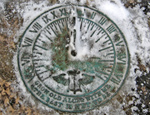 |
Highland Park |
Illinois |
USA |
Horizontal Dial |
Dial 55 |
| A cast bronze horizontal dial with hour, half-hour and quarter-hour lines and Roman hour numerals for 5AM to 7PM. Dial face symbol depicts a winged hourglass. |
| |
| |
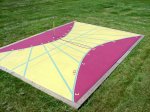 |
Hillsborough |
New Jersey |
USA |
Obelisk or Vertical Gnomon |
Dial 504 |
| A gnomonic horizontal dial constructed in bright colors on a 20 by 14 foot concrete pad. The gnomon is a vertical steel pipe 1 meter tall with a small nodus at the top. Hour lines are marked within summer and winter solstice and equatorial lines. The dial is marked with both standard and daylight local solar time. The noon line is complemented by its analemma with the months labeled. The sundial is used by Sunnymead School to aid in the science curriculum. The sundial was designed and created by Michael Folsom-Kovarik as an Eagle Scout project. Construction began on July 20, 2002 and ended on June 28, 2003. Michael was approached by Paul Stockman (the Home and School Association's treasurer) with the idea of building a sundial at Sunnymead School. Michael then came up with the design (made to keep the sundial as a useful teaching tool for the entire school day no matter what time of year) and location. After a year and a half from planning to completion, Sunnymead Elementary has a working and accurate sundial! |
| |
| |
 |
Hilton Head |
South Carolina |
USA |
Horizontal Dial |
Dial 1071 |
| A self-proclaimed "World's Largest Figurative Sundial" centers on a 12 foot (3.6m), 3000 pound (1360 kg) statue of Neptune. His trident, set at an angle of 32 degrees, serves as the gnomon. This massive structure sits on a low dais 26 feet (8m) in diameter, surrounded by low octagonal steps. Neptune is an impressive sculpture by Wayne Edwards. But the hour lines are a disaster. "Edwards enlisted the help of experts Frank Yerkes and Richard Hamilton of the engineering firm Sea Island Engineering, now known as Sea Island Land Survey, LLC" They could find north (and there is an "N" in the chapter ring indicating true north, but regardless of the story about sighting Polaris, the noon mark is aligned -8 degrees to the west, pointing to magnetic north). More serious is the marking of hour lines from IV (am) to VIII (pm). The VI hour lines are opposite, but drawn to the center of the dais that is easily 9 feet (3m) from the base of the trident gnomon where they belong. This great structure will never tell solar time. |
| |
| |
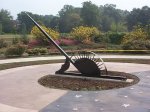 |
Hollidaysburg |
Pennsylvania |
USA |
Horizontal Dial |
Dial 437 |
| This is a large horizontal dial 10 feet in diameter, constructed of marble with a steel gnomon. The sundial was donated in honor of Courtney Leigh Clayton and is open to the public as part of the beautiful Discovery Garden. |
| |
| |
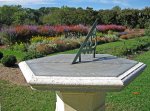 |
Hollywood |
Maryland |
USA |
Horizontal Dial |
Dial 373 |
| A 26 inch hexagonal, English-made slate horizontal dial with a 3/8-inch thick, knife-edge bronze gnomon and no noon gap. Dial face has hour, half-hour and quarter-hour marks in inner bands, and 3-minute marks in the outer band. Hours are marked with Roman numerals.
The dial sits on a hexagonal pedestal carved with coats-of-arms of families that lived at the plantation, including the Plater, Briscoe and Satterlee families.
The dial face has four concentric bands of hour numerals. The outer band reads local time with an inscription that notes local noon is also noon at Boston, Peru and C. Redondo, and midnight at Borneo and Chinese Tartary. The second band shows noon in New Zealand, London and other locations. Two additional inner bands show noon in still other cities around the world.
The plantation house overlooking the Patuxent River was constructed between 1710 and 1717 by James Bowles. Bowles died in 1727 and Sotterley Plantation passed through Plater and Briscoe ownership. The plantation was bought by Herbert L. Satterlee in 1910 and restored, including his vision of an 18th century garden in which he placed this sundial, received as a gift, in 1925.
Admission fee is required. Call 301-373-2280 for hours. |
| |
| |
 |
Holt |
Michigan |
USA |
Equatorial Dial |
Dial 646 |
| A four foot high equatorial dial possibly of painted cast aluminum on a four foot high segmented granite pedestal. Hour ring displays Roman numerals for EST with five minute marks with longitude correction. Tiles of pedestal bear names and birth/death dates of those memorialized. |
| |
| |
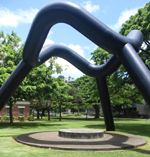 |
Honolulu |
Hawaii |
USA |
Sun Alignment |
Dial 1090 |
| "Sky Gate" is a huge 24 foot (7.3m) undulating sculpture of black metal is known as one of Honolulu's most distinctive pieces of public art. There is a hidden astronomical alignment. On zenith days (~28 May and ~18 July) when the sun is directly overhead at the zenith at the moment of local solar noon, the shadow of the sculpture forms a perfect, large circle on the ground directly below. The zenith day noon is known as "Lāhainā Noon", a term coined by the Bishop Museum, and in Hawaiian means "Cruel Sun". Noguchi, the sculptor, didn't leave a plaque, but Tory Laitila, registrar at the Mayor’s Office of Culture and the Arts, says, "Art is a subjective experience, and artists like to leave things for the viewer to discover." Now the Lāhainā Noon is well known and there is usually a crowd with cameras to document this twice annual event. |
| |
| |
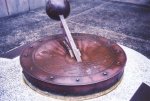 |
Honolulu |
Hawaii |
USA |
Horizontal Dial |
Dial 278 |
| The dial is a raised horizontal circle 18 inches in diameter. The nearly inch-wide brass gnomon supports a raised relief globe, with the Hawaiian Islands uppermost to accurately show which part of the world is in sunlight. The dial has hour lines and a ring of 5-minute marks. Hours are numbered from 6 until 18. Cardinal points and magnetic north are indicated. Dial shows some signs of deterioration. Designer Ginnosuke Ohara is a dialist with Japan's Research Institute for Sundials. The dial base is a mushroom design of concrete about 40 inches high and 40 inches in diameter. A time capsule is located in the base, to be opened in 2030. |
| |
| |
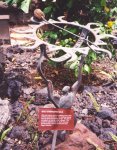 |
Honolulu |
Hawaii |
USA |
Equatorial Dial |
Dial 340 |
| As of May 2012, this dial was removed from display by museum staff.
Bronze equatorial dial 20, inches in diameter. The dial is outlined by an ornate ring tilted in the plane of the polar axis with extending flames representing the sun. A gnomon rod bisects this ring. The dial base is a statue of the Hawaiian mythological figure Maui snaring the sun, Kala, with ropes to snare the sun. The dial itself is a semicircular portion of an equatorial ring with inscribed hour lines and raised Roman numerals. The dial has been exhibited in various museums in San Diego, San Francisco, Seattle and Vancouver before permanent installation at the Bishop Museum in Honolulu. Gnomon and equatorial ring appear misaligned for 21 degree latitude. The museum is will correct the dial in the near future. |
| |
| |
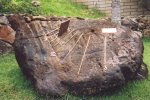 |
Honolulu |
Hawaii |
USA |
Vertical Dial |
Dial 481 |
| An elegant vertical declining and reclining dial built on the sloping face of a large lava boulder. Total size of the dial is 4 1/2 x 6 feet and uses a half-inch thick copper gnomon 6 x 10 inches. Hour lines and numerals at 9, 12, and 3 are of brass. The dial is corrected for longitude and was designed to fit its deep valley location and orientation of the boulder. Tradition holds that these rocks have spirits and must be treated with respect. |
| |
| |
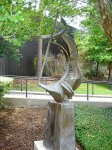 |
Houston |
Texas |
USA |
Sculpture/Artwork |
Dial 275 |
| An 85 inch high bronze sundial-like sculpture with elevated horizontal semicircular ring and steeply inclined bar up from base. Pegs and marks on ring suggest hour marks but design is wrong for location.
Work is dedicated to exploration of space and has been relocated to a very shady area. |
| |
| |
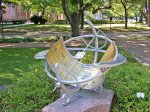 |
Houston |
Texas |
USA |
Cylindrical Dial |
Dial 683 |
| A 32 inch partial armillary of anodized aluminum and steel with wide equatorial and horizon rings and with equinoctial colure, Arctic and Antarctic circle rings. The gnomon includes an aperture to project a solar image on the wide equatorial ring, which includes EOT corrections, graphic for date determination and Zodiacal symbols. Reverse of gnomon aperture includes the university crest. Horizon ring graphic shows time of sunrise/sunset throughout the year. Dial is partially shaded by surrounding trees. Dial sits on an approximately 4 foot high polished granite pedestal |
| |
| |
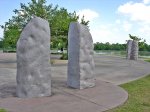 |
Houston |
Texas |
USA |
Sun Alignment |
Dial 684 |
| A large concrete, paving stone and standing stone calendrical dial with interior labyrinth. Outer ring shows NESW alignments. Four split standing stone portals are aligned for summer and winter solstice sunrise and sunset. An inner ring contains 13 trees representing the 13 cycles of the moon. |
| |
| |
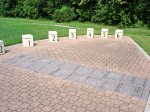 |
Houston |
Texas |
USA |
Analemmatic Dial |
Dial 686 |
| A large analemmatic dial of paving stones, square limestone hour posts with Arabic hour numerals and polished granite date line. Hour numerals show Standard Time. Dial has a concrete border around perimeter. |
| |
| |
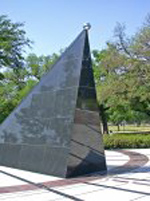 |
Houston |
Texas |
USA |
Horizontal Dial |
Dial 68 |
| Monumental size sundial with a black granite gnomon shaped as a tetrahedral with a small silver ball nodus at the peak. The 12 foot gnomon has a slope of 29.72 deg matching the latitude of Houston. The dial face is white granite with black granite stripes for hour lines, each marked by Roman numerals.granite stripes for hour lines. Along each hour line are markers for month pairs when the shadow of the nodus passes over. These markers are connected by thin declination lines, including the limits of summer and winter solstice and the straight line showing the equinox. |
| |
| |
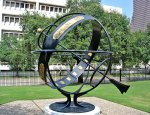 |
Houston |
Texas |
USA |
Armillary Sphere |
Dial 244 |
| A 72 inch painted steel armillary dial with meridian, equatorial, horizon, Arctic and Antarctic rings. Equatorial ring has hourly Roman numerals and zodiacal symbols on its exterior.
A bronze plaque on the base explains the armillary operation and provides a table of combined EOT and longitude corrections. Since Houston is more than 5 degrees from the time zone meridian, the longitude correction is almost 22 minutes, greater than the largest EOT correction, resulting in the combined corrections to always add to the dial time. Dial is mounted to a two foot diameter concrete pedestal.
This dial was restored in 2000 by the Houston Municipal Art Commission funded by Searcy and Elizabeth Bracewell. |
| |
| |
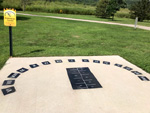 |
Houston |
Minnesota |
USA |
Analemmatic Dial |
Dial 985 |
| A simple analemmatic dial laid out in a square concrete base. The walkway and hour surrounds are black with white lettering. The hours are Roman numerals run from VI (morning) to VIII (evening). The dial is adjusted for daylight saving time and longitude such that when the sun is on the meridian, the dial shows about 6m after 1pm. |
| |
| |
 |
Houston |
Texas |
USA |
Horizontal Dial |
Dial 1115 |
| In the Sharp Family plot is a lovely statute titled Roses of Yesterday of a lady holding wilted roses in one arm and a sundial in the other. The dial itself is circular, approximately 12 inches (30.5cm) in diameter. The hour marks in a narrow chapter ring are Roman Vi to VI, divided into quarter hours. The original gnomon was set to the 6-6 line at the extreme south of the dial, but until circa 2019-2020 the gnomon had long been missing, Since then, a new gnomon has been installed but it is a disaster: It is set backwards, it is the wrong size, and cut at the wrong angle for Houston. It would be a service to the lovely statue and dial to remove the gnomon. |
| |
| |
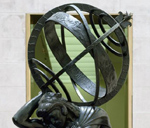 |
Houston |
Texas |
USA |
Armillary Sphere |
Dial 863 |
| The armillary sundial is part of the statue Hercules Upholding the Heavens. The statue portrays the ancient Greek hero Hercules performing the eleventh of his twelve labors, holding the heavens on his back for Atlas. The bronze sculpture is 1,650 pounds and over 10 feet tall. In 1917 Paul Manship was asked by Charles Schwab (Bethlehem Steel) to create this sculpture for his garden at his newly completed mansion. |
| |
| |
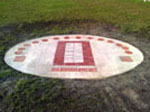 |
Howell |
Michigan |
USA |
Analemmatic Dial |
Dial 788 |
| A 16 by 20 foot, two-tone concrete analemmatic dial with 7 AM to 8 PM Arabic hour numerals on 12 inch round stamped concrete disks. Instructional and use information is shown on impressed lettering colored concrete plates. |
| |
| |
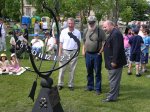 |
Humboldt |
Saskatchewan |
Canada |
Armillary Sphere |
Dial 560 |
| An equatorial armillary. |
| |
| |
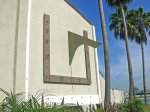 |
Huntington Beach |
California |
USA |
Vertical Dial |
Dial 78 |
| A 7x8 foot direct south facing vertical dial of wood with metal gnomon on the masonry stucco side of a fire station building. Hour lines are painted on wood planks bolted to the side of the building. Metal Arabic DST hour numerals are mounted to the wood planks. Longitude correction is not included and there is no EOT correction or instructions offered but dial is accurate when both corrections are applied. |
| |
| |
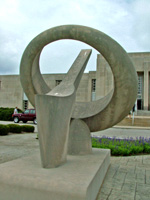 |
Indianapolis |
Indiana |
USA |
Equatorial Dial |
Dial 220 |
| A five foot diameter donut-shaped full circle equatorial pierced by equally massive Indiana Limestone shaft as gnomon. Hour numerals are Arabic. Subdivided into 15 minute increments. Equation of Time is given in the plaque at base |
| |
| |
 |
Indianapolis |
Indiana |
USA |
Sculpture/Artwork |
Dial 276 |
| A stainless steel and concrete vertical structure 33 feet tall called the "Totem". It has triangular and trapezoidal cut-outs, placed in the center of a concrete circle, with a sundial face but is not a functional sundial. |
| |
| |
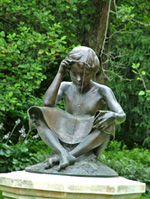 |
Indianapolis |
Indiana |
USA |
Sculpture/Artwork |
Dial 305 |
| Bronze Sundial, Boy with Spider
Gnomon wire is broken but present as of 2/2014. |
| |
| |
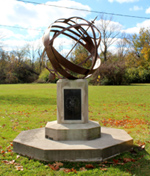 |
Indianapolis |
Indiana |
USA |
Armillary Sphere |
Dial 957 |
| This armillary is constructed adjacent to the original American Legion Wayne Post 64 building. It is made of iron with iron hour markers in Roman numerals on the equatorial band. It has arctic and antarctic circles and a longitude band from 6am to 6pm. The 45-inch diameter sphere sits atop a plain but elegant white square pedestal and octagonal dais. On the side of the pedestal are black marble plaques etched with the symbols of the Army, Navy, and Air Force. On the fourth side is the seal of the United States. |
| |
| |
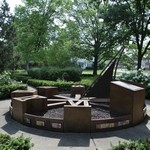 |
Indianapolis |
Indiana |
USA |
Horizontal Dial |
Dial 1006 |
| Nestled among the trees in a small triangular park is a monumental horizontal sundial with oversized hour marks. The apparent method of reading the Roman hours that are all south of the 6am - 6pm line, is to look at the shadow then gaze across the sundial to read (upside down) the hour. The hours are 6, 9 ,12, 3, and 6. On the north side of the 6am-6pm line are 3 plaques where the normal 9, 12, and 3 hours should be. One is a plaque for Robert McCord who planted and maintained the park during the 60's until his death. Another plaque records that the McCord Park sundial is dedicated to a local police officer, William Whitfield, who was the first African American police officer killed in the line of duty in Indianapolis. His name is engraved on the central part of the large triangular sundial gnomon. Surrounding the base of the sundial are ceramic tiles from Barbara Zech, a local clay artist who fired the tiles created by students from the nearby school. The tiles have the theme of "home" and "community". The park renovations were headed by the group Keep Indianapolis Beautiful. |
| |
| |
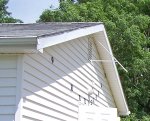 |
Ionia |
New York |
USA |
Vertical Dial |
Dial 629 |
| A 16 x 6 foot wood and steel vertical dial on the south wall of the Louis S. Wolk Observatory at the Marion and Max Farash Center for Observational Astronomy. Dial declines 16.3° W of S. Dial displays EDT with longitude correction. Pedestrian and equine access is unrestricted but vehicular traffic is limited to members. |
| |
| |
 |
Iowa City |
Iowa |
USA |
Equatorial Dial |
Dial 970 |
| An 2-foot diameter dial with a wide 8-inch equatorial band. Vertical lines mark half hours from 5 am to 7pm in Arabic numerals placed at both the top and bottom of the band. Zodiac declination with month and dates engraved. The shadow nodus is held in place by a horizontal rod. Time and date marks are faint, implying that the dial has been continually polished over the years. |
| |
| |
 |
Isles of Shoals |
New Hampshire |
USA |
Armillary Sphere |
Dial 97 |
| Simple armillary dial about 2 feet in diameter sits on a triangular cut stone pedestal. The equatorial band has raised Arabic numbers at each hour. The hours are adjusted by 42 minutes to correct for zone time. The gnomon is an arrow rod of traditional fashion. The base supporting the armillary is a small hemisphere globe, with a map of the continents plainly visible. The armillary cuts the globe at the Greenwich hour line facing due north. The triangular granite stone pedestal was once part of the Captain John Smith Monument, commemorating him as the discoverer of the Isles of Shoals in 1610. |
| |
| |
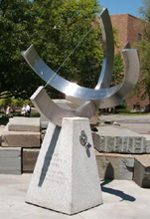 |
Ithaca |
New York |
USA |
Equatorial Dial |
Dial 99 |
| This 650 pound equatorial has a gear adjustment to rotate the equatorial time ring using a knob on the side of the pillar. This allows correction for the Equation of Time (sun's apparent variability in crossing the noon meridian and enables the instrument to read clock time, making this a very precise instrument. The gearing rusted in 1980 and was refurbished: "The heart of the sundial's functionality, a roundish steel disc called a cam, was also replaced with a stainless steel, slightly better-functioning one, connected to an hour and minute scale by small, stainless steel cables via a pair of precisely designed pulleys." Thus the mechanical adjustment compensates for the sun's irregular motion called the Equation of Time and shows civil not solar time. |
| |
| |
 |
Ithaca |
New York |
USA |
Horizontal Dial |
Dial 463 |
| A horizontal sundial made from a an irregular slab of stone approximately 18 x 24 inches. The hour markings are inscribed in the form of an arrow pointing to the 12 o'clock hour and the gnomon is a thin blade. In keeping with the herb garden's design, maker and designer Michael Sweeney used native materials of stone for the dial and pedestal. The dial base was a prized antique millstone of orange granite from a nearby village. |
| |
| |
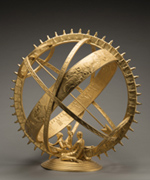 |
Jackson |
Mississippi |
USA |
Armillary Sphere |
Dial 288 |
| A 30 inch gilded bronze armillary sphere, titled "Cycle of Life". The armillary sphere is composed of rings representing the great circles of the heavens. The sundial symbolizes the cycle of life encompassed by the cycle of eternity. Figures of a man, woman and child represent the Cycle of Life. On the rings and base are depicted the elements, seasons, hours of the day and signs of the zodiac. All is held up by circle of tortises. |
| |
| |
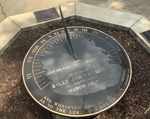 |
Jackson |
Mississippi |
USA |
Horizontal Dial |
Dial 387 |
| A large, 4-foot (1.2m) brass horizontal dial with clean lines. Time is marked in quarter hours from 5AM to 7PM. Hours are in Roman numerals. Dial sits in the middle of an octagon dais supported on a square concrete block. The gnomon is a simple blade, but the engraving on the dial says "Lat 39.3 N" and is clearly wrong. The dial honors Billy Jim Thompson for his support of the Academy. He died in 2014 at the age of 91. |
| |
| |
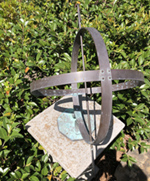 |
Jackson |
Mississippi |
USA |
Armillary Sphere |
Dial 1061 |
| This is a copper armillary sphere about 18 inches (46 cm) in diameter. It has a traditional gnomon rod and arrow motif. The equatorial ring has both standard (6AM to 6PM) and daylight saving time hour marks in Arabic numerals. Noon is centered, showing local mean solar time. On the base is a graphic Equation of Time curve to correct to civil time. The dial sits on a square pedestal of cast concrete. |
| |
| |
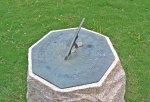 |
Jamestown |
Virginia |
USA |
Horizontal Dial |
Dial 724 |
| A 15 inch octagonal bronze horizontal dial with a bronze gnomon. Dial face shows hour, half-hour, quarter-hour and 5-inute marks with Roman hour numerals. The gnomon is damaged and analysis shows the dial hour lines are laid out for approximately 45° latitude instead of the local 37° latitude. The dial is on a white granite pillar. |
| |
| |
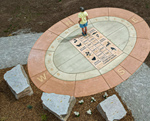 |
Janesville |
Wisconsin |
USA |
Analemmatic Dial |
Dial 1065 |
| This 21 ft x 16 ft (7m x 5m) analemmatic sundial has a landscaped area with seating and a stone pier that holds a bronze dedication plaque and a bronze information plaque with a QR code for additional online information. The central zodiac walkway is a 2,500 pound pre-cast concrete slab that includes images of regional plants and animals next to their corresponding months to represent seasonal cycles as a reminder that nearly all life on earth is connected to the relative motions and positions of the sun and earth. The bronze hour numerals and bronze cardinal point letters are anchored into poured concrete rings that surround the walkway. The analemmatic sundial is modeled after the one at the Milwaukee County Botanical Domes. |
| |
| |
 |
Jemez Springs |
New Mexico |
USA |
Analemmatic Dial |
Dial 552 |
| Analemmatic dial of cast concrete 6m E-W by 2.2m N-S |
| |
| |
|
Jerico |
Vermont |
USA |
Horizontal Dial |
Dial 70 |
| 50 foot diameter horizontal dial of steel, concrete and stone. Called "Polaris". The gnomon is 10 foot high forming a stone pyramid. As the sun shines through a hole at the center, an analemma is traced on the ground. Markers identify equinox sunrises and solstice sunsets. The dial was built by Kate Pond and her students. See NASS Compendium Vol 1, No. 2, May 1994. |
| |
| |
|
Jersey City |
New Jersey |
USA |
Horizontal Dial |
Dial 434 |
| A horizontal dial 12 feet across made of concrete and pipe. |
| |
| |
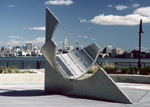 |
Jersey City |
New Jersey |
USA |
Equatorial Dial |
Dial 1091 |
| The equatorial sundial is a classic "bow string" sundial using a thin rod with a nodus to tell both time and date. The nodus is a small disk with a hole in the center to let a beam of sunlight fall near the noon hour line on the equatorial ring. The equatorial ring (a semi-circle) as the rest of the dial is stainless steel, The dial is 12 feet (4m) at the base and 12 feet (4m) in height, forming a 45 deg triangle in profile. |
| |
| |
 |
Johnson |
Vermont |
USA |
Horizontal Dial |
Dial 71 |
| One of Kate Pond's first dials, a winning design for an 18 foot diameter dial that now resides on the University of North Vermont - Johnson green. Concrete, Stainless Steel. On the ground concrete paths mark the N-S and E-W axes. The gnomon is a 3 inch stainless steel pipe 9 feet long attached to a concrete base. The hours are marked with 1 foot diameter Vermont granite stones, and at the cardinal points are larger stone markers. Kenneth Leslie, Assistant Professor of Art, remarked, " I have the idea of a student sitting against the North marker, reading a newspaper for a noon class, and knowing it's time to leave when the shadow crosses his paper." |
| |